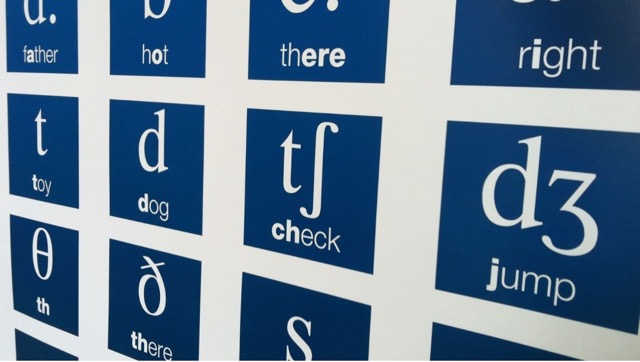Founded in Denmark. We respect your privacy.
Join a worldwide community of language learners
How to Reduce Accent Through Speaking Practice: Effective Strategies Unveiled
By Conor Monaghan
Reducing your accent in a foreign language involves understanding and practicing the sounds and rhythms of a language to speak more like native speakers. The process includes various strategies that aim to align your pronunciation closer to the target accent.
One effective tool at your disposal is the International Phonetic Alphabet (IPA). The IPA is a system of phonetic notation that provides a way to visualize and consistently produce every unique sound in a language.
By studying the IPA, you can gain insights into the nuances of pronunciation that may not be immediately apparent when you're listening to a language or learning it through traditional means.
To begin accent reduction, familiarize yourself with the phonetic alphabet, which covers the full range of sounds in your target language.
Let’s find out more.
Accents and Pronunciation
Accents and pronunciation are integral to effective communication, and speaking practice is a dynamic way to enhance both. This section dives into the complexity of accents, the role of phonetics, and the nuances of speech patterns.
The Nature of Accents and Their Impact on Speech
An accent reflects the unique characteristics and nuances of speech influenced by your native language, region, and personal experience. When you communicate in a second language, your accent can impact speech clarity and occasionally comprehension.
Becoming aware of how your native language influences your accent is the first step towards modification.
Phonetic Foundations: IPA and Phonetics in Accent Training
Phonetics provides a systematic approach to understanding speech sounds.
By learning the International Phonetic Alphabet (IPA), you equip yourself with a tool to identify and practice specific sounds that may not exist in your mother tongue.

The IPA is a universally recognized system representing each distinct sound, giving you a precise method for targeting pronunciation adjustments.
The Role of Intonation, Stress, and Rhythm in Speech
The melody of your speech is dictated by intonation, stress, and rhythm. These elements are essential for not only sounding natural, but also for conveying the correct meaning.
Intonation refers to the rise and fall in pitch as you speak, vital for expressing questions or emotions.
Stress marks the importance of a syllable or word within a sentence, impacting the intended message.
Meanwhile, rhythm involves the pattern of stresses and pauses, giving languages their characteristic beat.
Observing these components in native speech can greatly assist in aligning your pronunciation with that of fluent speakers.
Practical Techniques for Accent Reduction
To effectively reduce your accent through speaking practice, integrate proven methods such as active listening, focused exercises, and technology-aided practice into your daily routine.
Active Listening and Imitation Strategies
Begin by actively listening to the pitch and rhythm of a native speaker’s speech.
I like to use various media like podcasts or movies to become familiar with the sounds of the American accent, for example.
Pay special attention to the intonation—the rise and fall of the voice.
Once you have a grasp on these patterns, start the process of imitating the pronunciation of words and phrases you hear.
This not only involves mimicking their sounds but also their speech rhythm and melody.
- Listen: Choose high-quality recordings of native speakers.
- Imitate: Repeat phrases, focusing on the subtleties of the pronunciation.
Focused Pronunciation Exercises
You should dedicate time to pronunciation exercises that utilize the phonetic alphabet to ensure you understand how to produce specific sounds.
Practice challenging words repeatedly and record yourself to compare your pronunciation with that of a native speaker.
Moreover, practice target sounds regularly to understand the mouth and tongue positions for each phoneme.
- Identify target sounds that are difficult for you.
- Use exercises to repeat these sounds in varying contexts.
Mastering Vowels and Consonants
Speech clarity in English heavily relies on the accurate pronunciation of vowels and consonants. Recognizing and reproducing these sounds correctly is essential to reducing an accent.
Vowel Sounds and Their Importance in English
The English language contains a diverse array of vowel sounds that are central to its structure.
Distinguishable by their pitch and resonance, vowel sounds bear the weight of syllable formation. Each vowel can have several variations, known as phonemes, and it's vital to master these to achieve clarity in speech. Here's a concise approach:
- Short Vowels: Like the 'a' in "cat" or the 'e' in "bed", practice these by repeating words with short vowels, noting the quick and punchy sound.
- Long Vowels: These are often akin to the letter's name, such as the 'a' in "cake". They are generally held longer and involve a slight glide in the mouth.
- Diphthongs: These complex sounds combine two vowels, like the 'oy' in "boy". They start with one vowel sound and transition to another.
Mastering these sounds will help you control the tone, pitch, and rhythm of your speech, which are all critical elements for intelligible communication.
Conquering Consonant Pronunciation
Consonants create texture and rhythm in your speech. Their precise articulation is what makes words intelligible and distinct from one another. To refine your consonant pronunciation, consider these points:
- Voiceless vs. Voiced: Some consonants are pronounced with vocal cord vibration (voiced), such as the 'd' in "dog", and others without (voiceless), like the 't' in "top". Pay close attention to the presence or absence of vibration.
- Place of Articulation: Whether your tongue is behind your teeth for 't' and 'd', or your lips come together for 'p' and 'b', understanding where in the mouth consonants are formed is key.
- Manner of Articulation: How you release air plays a role — sharply for 't' and 'k', or continuously for 's' and 'f'.
By incorporating these vowel and consonant exercises into your speaking practice, you sharpen your enunciation and move closer to a natural-sounding English accent. Focus on the mechanics until they become second nature.
Talkio AI
Talkio AI is a cutting-edge language learning app that leverages artificial intelligence to help users improve their oral language skills, particularly their pronunciation.
By providing instant feedback and correction, Talkio AI enables learners to practice their pronunciation consistently and effectively. The app engages users in an interactive language learning experience, making it an ideal tool for those seeking to perfect their accent and pronunciation.

With AI-powered features and a focus on frequent, targeted practice, Talkio AI is revolutionizing the way people learn and master new languages online.
Developing Effective Practice Routines
To effectively reduce your accent through speaking practice, it is crucial to establish a well-structured routine that incorporates consistent practice, self-evaluation, and feedback from native speakers.
Creating a Consistent Practice Schedule
Consistency is the cornerstone of accent reduction. To see progress:
- Establish a daily practice time: Choose a specific time each day dedicated to practice.
- Set realistic goals: Begin with short, manageable sessions and gradually increase duration.
- Incorporate variety: Include different types of speaking exercises to cover all aspects of language.
Recording and Self-Evaluation
Self-analysis is a powerful tool for improvement:
- Record your practice sessions: Use a voice recorder or your smartphone to capture your speaking.
- Listen attentively: Pay close attention to pronunciation, rhythm, and intonation.
- Compare recordings: Regularly compare your recordings to monitor your progress over time.
Seeking Feedback from Native Speakers
Constructive feedback from native English speakers can provide invaluable insights:
- Engage with native speakers: Practice conversations with native English speakers whenever possible.
- Ask for specific feedback: Request comments on particular areas of your accent you're working to improve.
- Use online resources: Participate in language exchange communities to gain feedback if in-person interaction isn't possible.
Resources and Exercises for Continued Learning
To effectively reduce your accent, continuous practice and exposure to English are paramount. This section focuses on practical tools and exercises that will enhance your learning journey by providing consistent and varied speaking opportunities.
Online Platforms and Materials
Online platforms offer a gold mine of resources designed specifically for language learners looking to reduce their accents.
Start with instructional videos that demonstrate the nuances of English pronunciation, and incorporate complementary exercises for repetitive practice.
For example, you can use videos that break down the rhythm and pitch of native speakers, enabling you to replicate these patterns.
Online accent reduction courses often come with interactive materials for you to practice and record your own speech, allowing you to receive immediate feedback.
AI Tools
AI-powered accent reduction tools are transforming the way individuals work on neutralizing or softening their accents. These innovative solutions harness the power of artificial intelligence to provide real-time feedback and suggestions, enabling users to practice their pronunciation and improve their speech clarity.
By analyzing speech patterns and identifying areas for improvement, AI accent reduction software can offer personalized guidance and exercises tailored to each user's unique needs.
As AI technology continues to advance, these tools are becoming increasingly sophisticated, offering features such as accent matching, pronunciation correction, and even real-time accent conversion.
With the help of AI, individuals can now practice accent reduction at their own pace, from the comfort of their own homes, and achieve more natural-sounding speech in their target language.
Interactive Learning with Language Partners or Exchange Programs
Finding a language partner or joining a language exchange program can greatly accelerate your accent reduction.
These programs connect you with native speakers, who help you practice speaking English in a conversational setting.
This real-time speaking experience is crucial for practicing the sounds and intonations you've been learning.
Make sure to focus on the most challenging aspects of your accent during these sessions, as consistent, targeted practice is key to improvement.
Supplementing Practice with Audiobooks and Podcasts
Audiobooks and podcasts are excellent resources for accent reduction as they expose you to English in various contexts and vocabularies, ranging from formal to colloquial language.
Listen to how words are pronounced in different settings and try mimicking the speakers to improve your intonation and stress patterns.
This can be done passively during commutes or actively by pausing after sentences and repeating them out loud.
Tips for Enhancing Speaking and Listening Skills
Developing refined speaking and listening skills is essential for accent reduction and effective communication. This section provides practical strategies for improving your abilities in these key areas.
Listening Skills Development
Understanding Rhythm and Intonation: Pay attention to the rhythm and intonation patterns of native speakers. Listening actively to podcasts, songs, and conversations helps you recognize and mimic the natural flow of the language.
Consider:
- Repetition: Listen to the same audio multiple times.
- Transcription: Write down what you hear to train your ears.
Communication Skills and Body Language
Effective Use of Non-Verbal Cues: Over 50% of communication can be non-verbal. Enhance your communication effectiveness by incorporating appropriate body language, including:
- Eye contact: Shows confidence and interest.
- Gestures: Complement and emphasize your spoken words.
Adapting to Various Accents of English
Exposure to Diversity: To become a versatile communicator, expose yourself to different English accents. This can include:
- Media: Watch films and series in various dialects.
- Conversations: Engage with speakers from different regions.
Practicing with speakers of varying accents will help you understand and be understood by a broader range of English speakers.
Overcoming Psychological Barriers to Accent Reduction
Reducing an accent is as much a psychological process as it is a linguistic one. You need to build confidence and maintain a positive attitude, while also grappling with issues of authenticity and identity.
Building Confidence and a Positive Attitude
Confidence is key to successful accent reduction, yet it might be the most challenging aspect for non-native English speakers.
Start by setting small, achievable goals that will enable you to track your progress and celebrate successes, no matter how minor they seem.
Be mindful of your self-talk; it should be positive and encouraging.
Remember, everyone’s accent reduction journey is unique, and yours does not need to be perfect.
- Acknowledge successes: Each small victory is a step closer to your goal.
- Positive self-talk: Replace "I can't" with "I'm learning to".
Authenticity and Identity in Language Learning
As you practice your accent reduction, it's important to balance improvement with authenticity. Your accent is a part of your identity and personal story.
Embrace the process as an expansion of your communicative skills, not a replacement of your cultural heritage.
Be authentic to yourself by recognizing that reducing an accent does not mean erasing it; it means striving for clearer communication while respecting your linguistic background.
- Embrace your story: Identify with your linguistic background as an asset, not a barrier.
- Clear communication: Aim for clarity in speech as your primary goal rather than complete accent elimination.
Frequently Asked Questions
In this section, you'll find concise responses to common inquiries about accent reduction through speaking practice. Each question targets practical advice that you can apply to your own learning process.
What are effective techniques for accent reduction during self-study?
To reduce your accent during self-study, focus on exercises like phonetic drills that target specific sounds in your second language.
Regularly listening to native speakers and repeating after them can help you understand the rhythm and intonation of the language.
Are there specific accent reduction exercises I can practice at home?
Yes, you can practice accent reduction at home by doing phonetic exercises, recording yourself speaking, and comparing your pronunciation to that of native speakers.
Intonation practice, such as mimicking the melody of sentences, can also be effective.
What are some reliable accent reduction apps or online platforms?
Reliable accent reduction apps and online platforms include those that offer personalized feedback, such as AI pronunciation tutors, or connect you with native speakers for practice, such as language exchange apps.
Can consistent speaking practice lead to a significant reduction in accent?
Consistent speaking practice is crucial and can lead to a significant reduction in your accent.
By regularly engaging in targeted speaking exercises, your pronunciation and overall speech patterns will become more aligned with native speakers.
How does speech therapy contribute to accent modification?
Speech therapy with a qualified specialist can provide personalized strategies for accent modification.
Therapists can identify specific pronunciation challenges and create a structured practice regimen to address them.
Is it possible to change my accent by practicing with native speakers?
Practicing with native speakers can facilitate a change in your accent. This type of immersive experience allows you to internalize the nuances of native speech patterns. Then, you can adjust your pronunciation accordingly.

Conor Monaghan
Conor was an English teacher for 10 years. He is interested in helping people with their English skills and learning about using AI tools at work.


